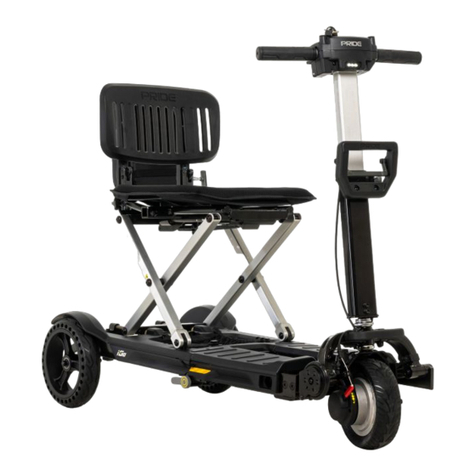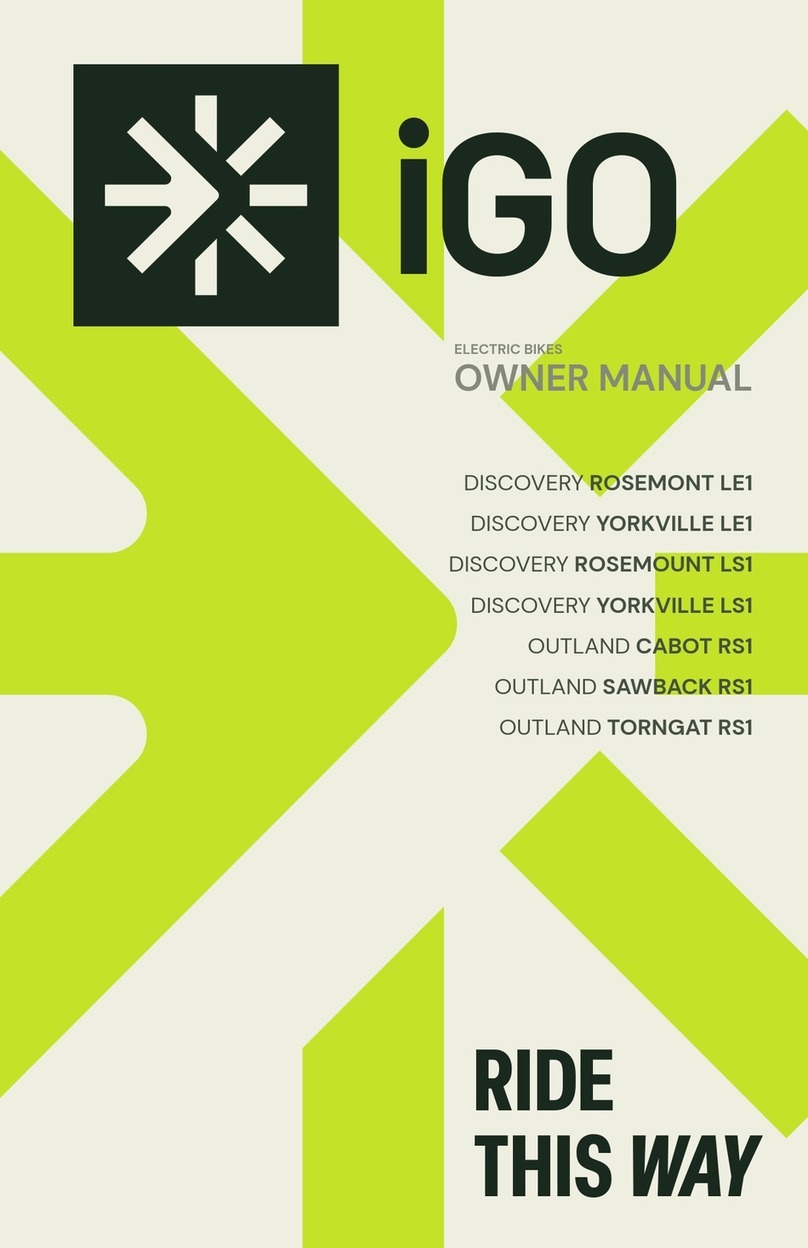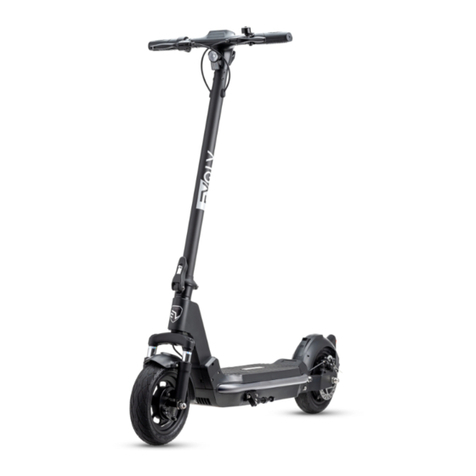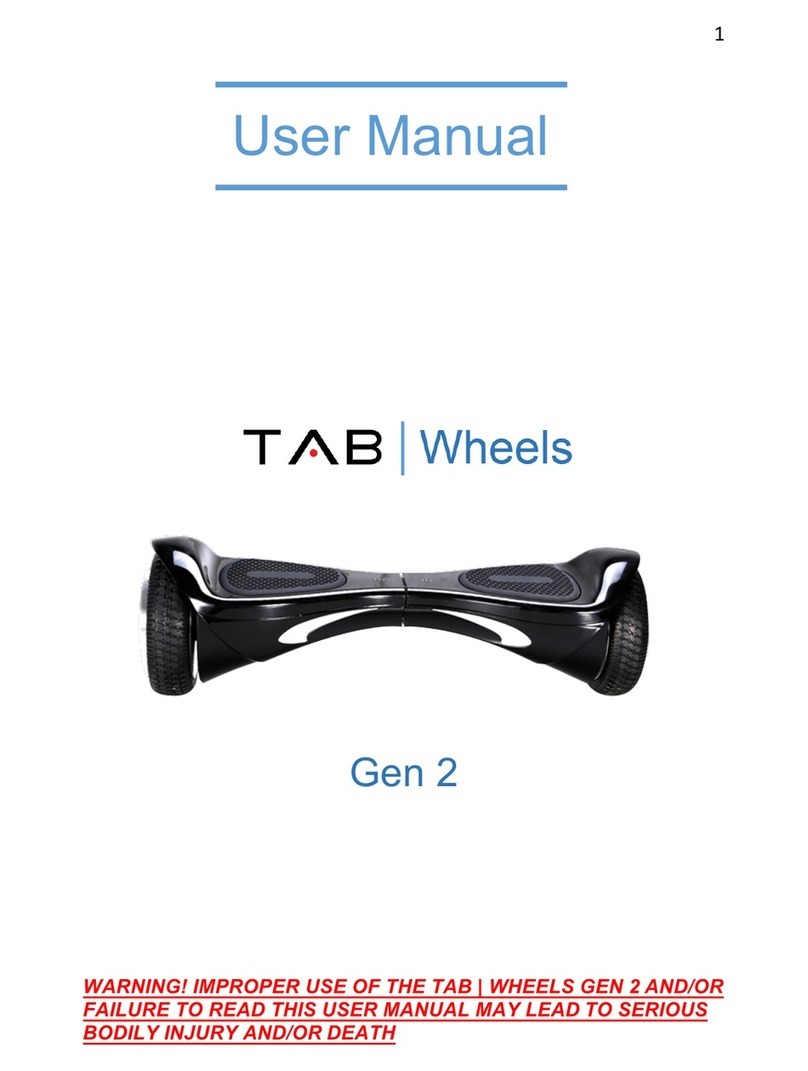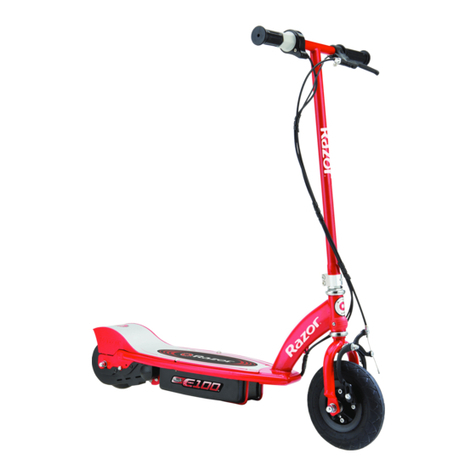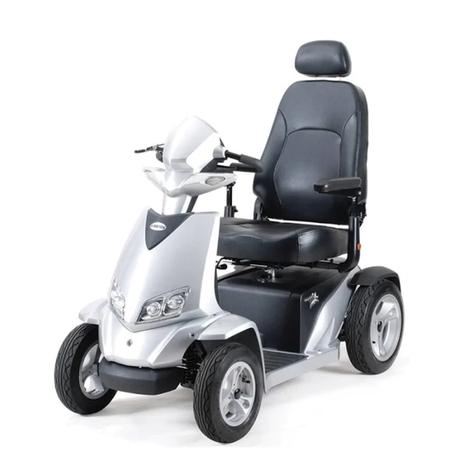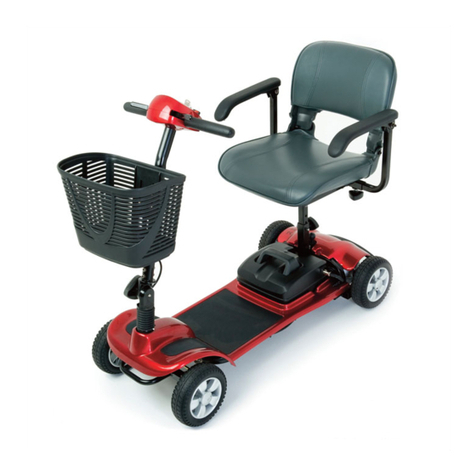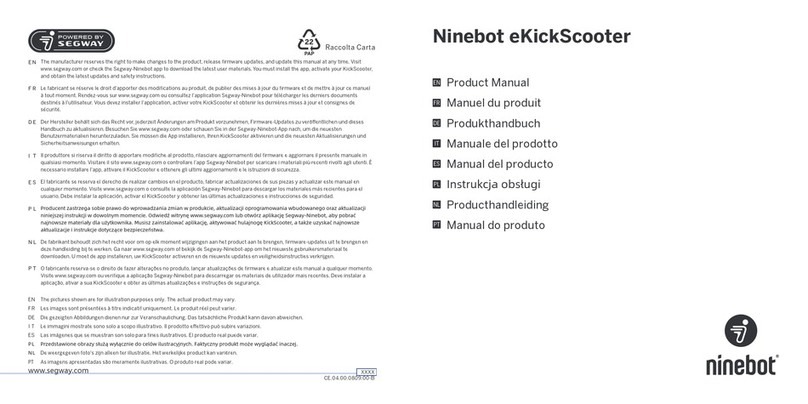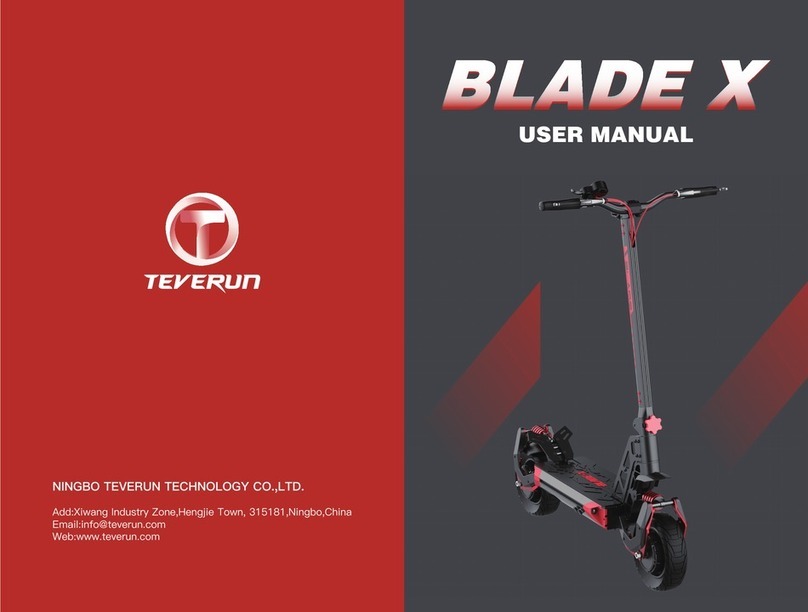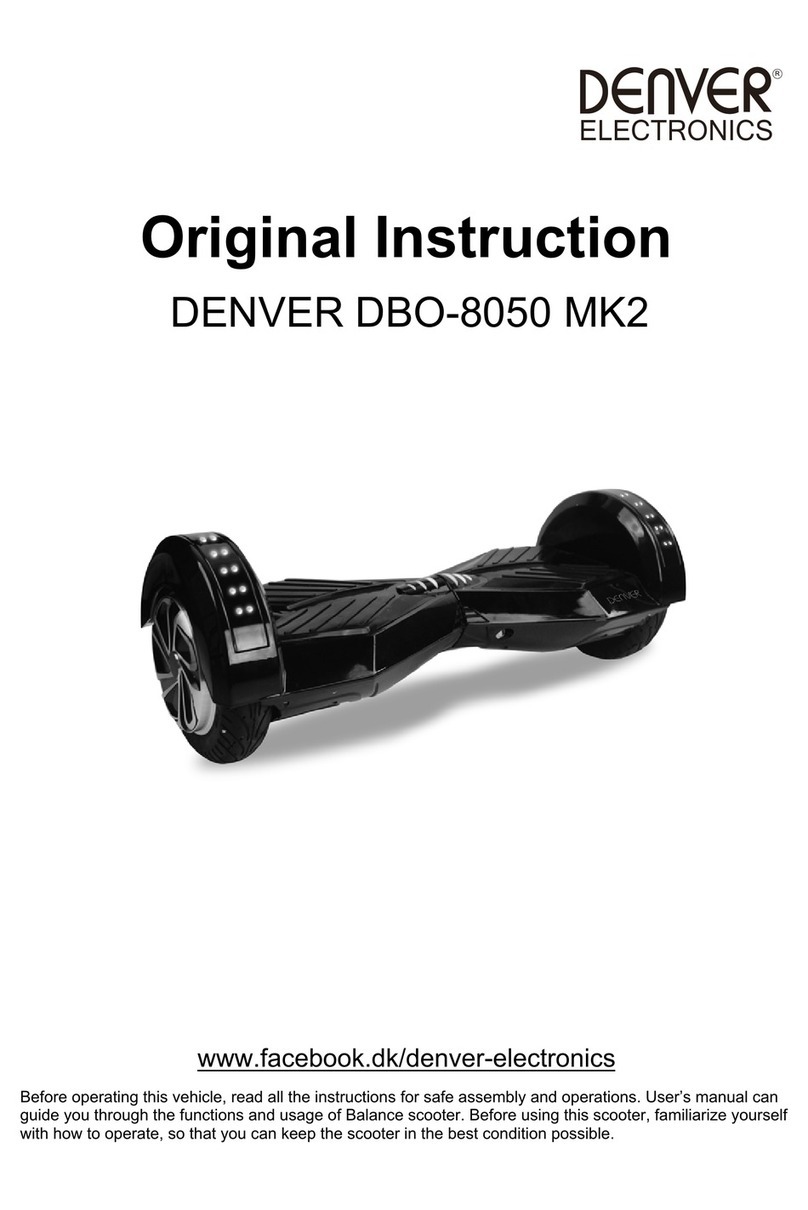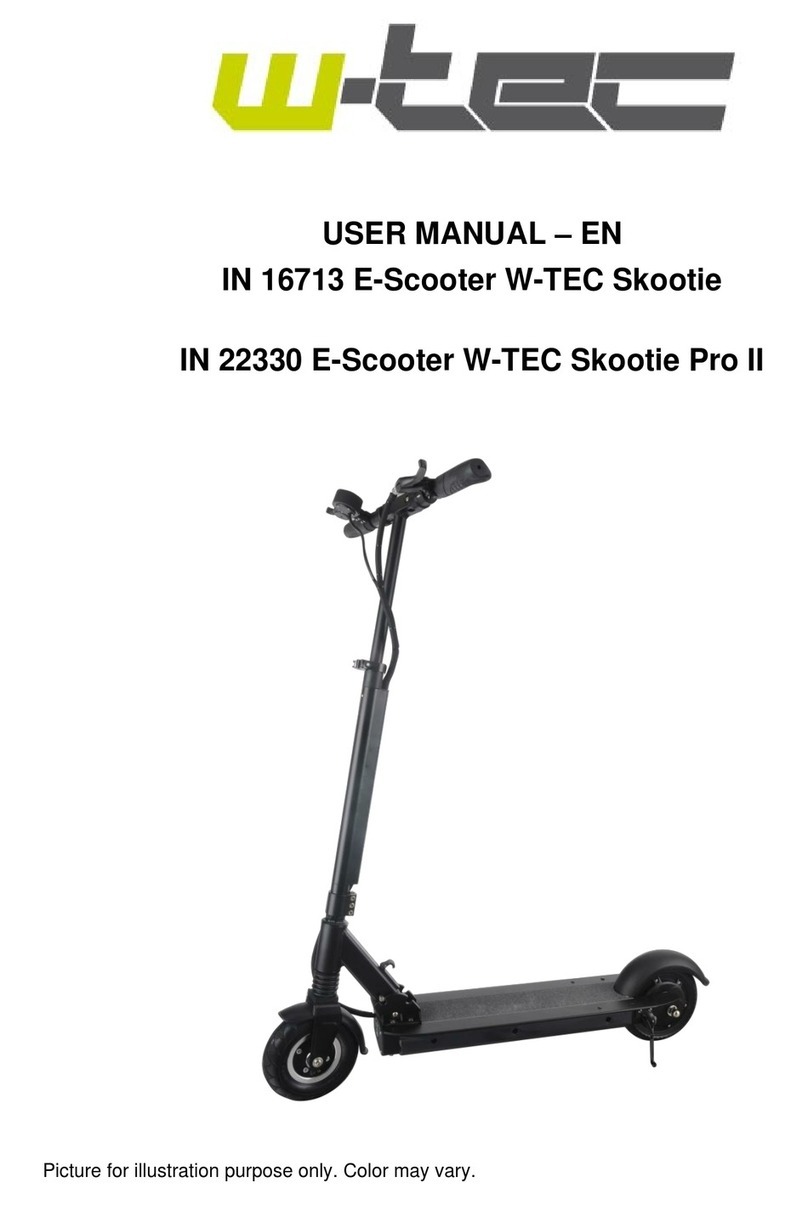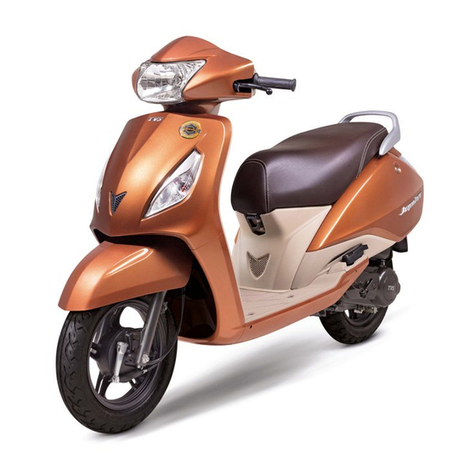I-GO Elite User manual

PLEASE READ THIS MANUAL BEFORE OPERATING
FOR FULL UNBOXING AND ASSEMBLY
INSTRUCTIONS, PLEASE GO TO :
http://www.igoelectric.com/buildmyelite
User manual
Elite
iGo Customer Service / Technical Support Toll-Free Number
1-866-996-6686
Mon - Fri 9:00 am - 5:00 pm EST

FRAME NUMBER / VIN NUMBER
The frame number is located on the left side of the frame, down below the
bottom bracket, under the barcode.
You will need the frame number of the ebike in order to register your ebike for
warranty purposes.
ATTENTION! Your ebike may dier from the illustrations in this manual.
Note:
iGO Electric reserves the right to make changes without notice to design(s)
and / prices listed in this manual.
This manual has be compiled with great care. iGO can not be held responsible
for any inaccuracies whatsoever.
iGO highly recommends having the ebike assembled and adjusted
by a professional bicycle technician.

Congratulations!
You are the proud owner of an iGO electric ebike.
We have taken great steps to create an incredible product and hope you enjoy
riding it as much as we did creating it.
With the help of our electric bike your riding experiences will be extremely
pleasurable and memorable and hope you will explore many new
surroundings.
The ebike is equipped with electronic pedal assistance which guarantees a
Completely new way of cycling.
Whether you use the ebike for commuting, shopping or just a leisurely ride,
you will do so comfortably and condently on your new iGo.
Chances are that you have not previously owned an electric bike with pedal
assistance. For that reason iGO has compiled a comprehensive user guide for
you. iGO encourages you to read through it carefully before riding your new
ebike to obtain a full understanding of your bikes features.
For more information, please visit our website at www.igoelectric.com.
T: 1-866-996-6686
@: support@igoelectric.com
W: www.igoelectric.com
Address : 1340, 55th Ave.
LACHINE, QC
H3T 3J8
11

2
Display & Its Functions 4
Buttons
Information on the screen
Controls
Settings Menu
Error Codes
Pedal Assistance 10
What is pedal assistance?
Turning pedal assistance on/o
More information on pedal assistance
Battery & Charging 12
Battery Range
Disconnecting and removing the battery
Charging the battery
Using the battery as a power source
How to store your battery during non use see page 13
Adjusting your eBike 16
Adjusting your seat height
Adjusting your saddle position
Adjusting your handlebars
Adjusting stem 17
Handlebar position
Aligning the brakes
Adjusting the brakes
Gears
Tire Pressure
Table of Contents

3
Front light installation 20
Maintenance 21
Servicing
General Maintenance
Cleaning
Warranty Information 24
Warranty
Warranty Limitations
Warranty Terms
Parts 22
Parts Diagram
Parts List
Warranty Card 27
PLEASE READ IMPORTANT BATTERY STORAGE
INFORMATION ON PAGE 13
IMPROPER STORAGE OF YOUR BATTERY COULD
RESULT IN TOTAL BATTERY FAILURE

Display & Its Functions
The battery must be in the ebike for the display to function. Make sure that
the battery is locked into the battery rack.
It is not necessary to keep the key in the lock while riding
Buttons
+
-
-
SET
SET
‘ON/OFF’: Powers ebike ON/OFF, Turns on lights when held
‘PLUS’ : Pedal assist level up, Walk assist when held
‘MINUS’: Pedal assist level down
‘SET’ : Scroll through display options, Settings Menu when held
4

Information on the screen
Speed
(km/h or mph)
Assistance Level
(0 - 8) Mode 0 = No assistance
Battery Indicator
5 Bars = Full Battery
Energy Consumption Indicator
Full bars = High battery consumption = Less range
Odometer
Total distance traveled
Trip Odometer
Distance travelled since last reset
Timer
Time since ebike was last turned on
Lighting Indicator
Appears when lighting system is on
Failure
See page. 9 for error code descriptions
Voltage
Indicates the current level of voltage of the battery
Driving-Mode
Indicates the chosen driving mode
*See page. 8 for instructions
5

Controls
Turning the ebike ON/OFF
Press and hold the Power Button for 2 seconds to turn the electric system on
or o. The control panel can only be used when the battery is connected to
the ebike. If the system is not used for a duration of 5 minutes, it will shut itself
o to conserve battery.
Selecting the display options
Press the ‘SET’ button to switch between the dierent trip functions of the
display. (Odometer, Trip distance, Timer, etc...)
Adjusting the pedal assistance levels
Use the ‘PLUS’ and ‘MINUS’ buttons to select the dierent levels
of pedal assistance. (0 - 8)
Power level 8 gives the strongest assistance from the motor.
In power level 0 the motor does not provide any pedal assistance or throttle
but you will still be able to use the functions of the display.
NOTE: The battery will run out of power quicker when using a higher level of
pedal assistance.
Throttle
Your bike is equipped with an on demand throttle on the left grip.
The throttle can only be used within pedal assist levels 1 though 8.
Level 0 is for conventional non electric riding.
Regardless of the power assist level you select the throttle is capable of
taking you to top speed.
You can use the throttle along with the pedal assist or on its own.
6

Lighting
With the ebike’s power on , tap the power button once to turn on the lighting
system.
This will turn on the backlight for the display, as well as the front and rear
lights. Tapping the power button once again will turn the lighting system o.
NOTE: The lighting system is powered through the ebikes lithium battery pack.
USB Connection
The USB Connection on the display can be used to power/charge devices
such as smartphones and navigation devices. It can be used when the ebike
is turned o, as long as the battery is still connected to the ebike.
7
ATTENTION! DON’T EVER USE YOUR MOBILE DEVICE WHILE RIDING
DON’T EVER TEXT WHILE RIDING
Attention
You must always wear an approved bicycle helmet when riding an
electric bike

Settings Menu
By holding the ‘SET’ button for 3 seconds you will enter the Settings Menu.
The Settings Menu will allow you to change certain features of your ebike.
Once in the Settings menu the word‘SET’ will begin to ash, pressing the‘SET’
button will allow you to switch between the dierent settings. The ‘PLUS’ and
‘MINUS’buttons will allow you to change the values of those settings.
Holding the ‘SET’ button again for 2 seconds will conrm the settings
Driving-Mode ( Auto Tuned )
The ebike comes equipped with 3 dierent riding proles;
ECO, NORMAL, and POWER.
Each riding prole will change the way the ebike performs.
• ECO Assist level 1,2 3 Lower motor power, Extended battery range
• NORMAL Assist level 4,5, Average motor power, Average battery range
• POWER Assist level 6,7,8 High motor power, Lower battery range
These riding proles are automaticaly adjusted depending on power assist
level to constantly optimize battery life
SET 1: Reseting the Trip Odometer
Tap the ‘ MINUS’button once to reset the Trip Odometer to ‘0’
SET 2: NO FUNCTION
8

SET 3: Setting the Tire-Size
Having the correct tire-size set into the system is very important. It will ensure
that the data being displayed on the screen is accurate.
On the side of every tire you can nd the tire-size.
Default Tire-Size of your ebike:
28 inch - 40-622 - Circumference: 2205 mm
SET 4: Choosing KM/H or MPH
Depending on your location, you will want to have the information on the
screen displayed in the proper unit.
Pressing the ‘PLUS’ or ‘MINUS’ buttons while in this mode will allow you to
switch between having the information displayed in kilometers or miles.
Error Codes
It is possible for a system error to occur.
When this happens, the display will show an error-code which will allow you
or your dealer to easilly and properly diagnose an error in the electrical
system of your ebike.
Error 1: Problem with the 3-phase control from the electronic controller
Error 2: Problem with the throttle connection
Error 3: Motor 3-phase wire is loose or defective
Error 4: Motor Hall Sensor signal malfunction (malfunction in motor or cable)
Error 5: Malfunction in brake sensor (signal)
Error 6: Battery voltage is too low
Error 7: Motor is stalled
Error 8: Malfunction in the electronic controller (signal)
Error 9: Malfunction in the display (signal)
9

Pedal Assistance
What is pedal assistance?
The bike is equipped with 8 levels of electronic pedal assistance.
As you pedal, the motor will assist you and enhance your pedaling eort.
This will allow you to pedal much further and faster but use much less energy
and eort. It is also a great feature when climbing a hill, as the motor will help
to make any climb easy.
Turning pedal assistance on and o
When you turn on the power to the display, the pedal assistance will
automatically be set to level 0. By using the ‘PLUS’ and ‘MINUS’ buttons, you
can increase or decrease the level of assistance. You can turn o the assistance
completely by pressing the ‘MINUS’button until the level of assistance is at
level “0”. This will allow you to use the lights and functions of the display, but
ride the bicycle without any pedal assistance from the motor.
Pedal assist levels 1-5 are meant to be used more on at roads or paths, the
higher levels (5-8) are more powerful and meant for hills, slopes, or heavy
circumstances.
If you prefer to ride slowly, it would be more comfortable for you to ride in
a lower power level. If you prefer to ride faster, then you should increase the
power level.
10
Derailleur functions
Your bike is equipped with a Shimano 8 speed derailleur.
Please choose the proper gear to match the riding terrain.
The use of a proper gear along with pedal assisted or conventional power will
enhance your riding experience
We recommend checking your derailleurs functions at least once a month

Safety Precautions while using the pedal assist & On demand throttle
• Since the motor is assisting you, you will easilly reach higher speeds than
you might be used to. We recommend that you ride the bike in a minimal
trac area at rst to become more comfortable with it.
• The operation of the pedal assistance depends on the speed at which the
pedals are rotated and your cycling speed.
• The electric motor speed is limited to a speed of 32 Km/h (20 m/ph). This
means that as you reach this speed electrical assistance stops and returns
when speed returns to 32km/h ( 20 mph )
• The level of pedal assistance will aect the battery range. Battery range is
dependant on many factors which are measured under average conditions.
It is dependant on, but not limited to, rider weight, speed, elevation, tire
pressure, wind, start-stop frequency, and outside temperature.
ATTENTION! Remeber that acceleration will be much quicker
with pedal assistance.
ATTENTION! Make sure to turn o the power when walking
next to, mounting, or dismounting the bike.
ATTENTION! Hold both brakes when stationary.
11
Attention
You must always wear an approved bicycle helmet when riding an
electric bike

Battery & Charging
Battery Range
How far can i travel on my electric bike?
The total distance you can travel on your electric bike is not an easy amount
to specify. The range depends on many dierent factors including, but not
limited to:
• Total Weight (weight of the bike + rider + cargo)
• Resistance (wind, tire pressure, speed, road conditions and altitude)
• Outside Temperature
• The level of pedal assistance and throttle usage
• The condition of the battery (battery capacity decreases as the battery ages)
Battery Capacity
Batteries are often compared based on capacity (Amp hours (Ah)).
However, a comparison based on capacity alone does not properly depict
a battery since the performance of a battery pack is also based on battery
voltage (V). The best way to compare battery performance is by looking at the
amount of energy that can be used in watt-hours (Wh). Wh take into account
both the capacity of the battery, as well as the average voltage during dis-
charge. Simply put, the higher the V/Ah, the higher Wh range!
Wh calculation ex: 48 V x 13 Ah = 624 Wh
PEDAL ASSITANCE LEVEL
RANGE
8
1
2
3
4
5
6
7
12

Disconnecting & Removing the Battery
On the top-left side of your battery is the battery lock.
This lets you lock/unlock the battery pack of the bike.
To Lock: Insert the bottom of the battery into its receptacle on an angle as
shown while pushing the top of the battery into the lock.( Turn key to unlock
position to facilitate the entry of the battery into the receptacle)
To Unlock: Insert the key into the lock and turn 1/4 turn clockwise.
Use the side handle on the left top side of the battery to help pull it out of the
battery receptacle
ATTENTION! Remove the key after installing the battery to prevent any
form of loss or theft to the key or the battery.
13
Important Battery storage information
When not using your bike for periods exceeding one month
please charge as follows:
1) Before storage make sure that the battery is not charged more than
50% so that it will except a periodic charge.
You cannot periodicaly charge a fully charged battery.
2) Once every month you must attach the supplied battery charger
and charge for a period of no more than 15 minutes.
3) Continue this procedure once a month until more frequent riding.
This process will make sure that your battery does not stay at a
specic rate of charge for long periods of time.

ATTENTION! Unplug the charger when the battery is fully charged, or
when charger is not in use.
ATTENTION! The battery will sustain permanent damage if not used
for a long period of time (ex: Winter storage). SEE PAGE 13
Please make sure to charge the battery once a month during this time .
ATTENTION! Please recycle your battery to an authorised recycling
company in your area
ATTENTION! Make sure to only charge the battery in a dry,
well venitalated area.
ATTENTION! When the battery is completely depleated you must
charge it immediately. If the cells are left depleted for a long period of
time, they may become irreparably damaged.
Battery Instructions
Charging the Battery
The battery can be charged both on and o of the bike.
Please identify your charging port (gure 14.1, 14.2).
First plug the chargers male plug into the battery, then plug the chargers
110 volt plug into your wall outlet. ( Do not use an extension for 110 volt )
The indicator on the charger will light green for a few seconds and if a
charge is necessary, the LED will turn red. The battery is fully charged when
the battery indicator LED becomes green .
Unplug the charger from the wall rst, and then from the battery.
If the battery is not mounted to the bike you can always check the battery
level as seen in gure 14.3.
14
g. 14.1 g. 14.2 g. 14.3

What you should know about your battery
• DO NOT connect the positive terminal of the battery to the negative
terminal.
• The battery is sealed and therefore is rain resistant, however,
DO NOT expose your battery to water.
• The battery should be recycled properly at the end of its life.
• The performance of the battery will decrease at low temperatures.*
• Under ideal conditions, the battery pack can be recharged aproximately
750 times. The performance will slowly decrease over time and
eventually will need to be replaced.
• DO NOT expose your battery to high temperatures (>50°C),
such as direct sunlight)
• Problems: remove the battery from the bike and consult your dealer.
• For long term storage see storage info page 13
• Use ONLY the supplied charger.
*The action mentioned is optimal at temperatures of approx. +/- 25°C.
The guideline is that the capacity will decrease by 1% at every 1°C
of temperature drop.
Using the battery as a power source
The battery pack comes equipped with its own USB connection.
This allows it to be used as an external power source which can be used to
charge a smartphone, laptop, or other device that can be charged through a
USB connection.
See below to locate your USB port
To use the USB connection, just lift the rubber cap with the USB sign on it.
15
Bottom of battery Top right corner

Adjusting your Ergot
Adjusting your seat height
Your seat height should be adjusted properly to ensure you get the most
comfortable ride possible. The seat height is properly adjusted when your
knee has a slight bend when sitting on the saddle with your foot on the pedal
at its lowest position (gure 16.1). The seat height can be adjusted by
loosening the lever on the seat tube clamp gure 16.2. Make sure to
retighten after adjustment .
ATTENTION! Ensure that the safety marks for max. height written on the
seat post are not visible when retightening the hex bolt.
ATTENTION! If you can put your feet at on the ground while seated,
your seat height is too low.
Adjusting your saddle position
You can tilt the saddle to change the seating angle, as well as, slide it
backward or forward (gure 16.3). To adjust the saddle, loosen the nut
located on the underside of the saddle with a wrench (gure 16.4). You will be
able to move the saddle around to suit your preered riding style. When you
are done adjusting, make sure to retighten the nut.
16
g. 16.1 g. 16.2
g. 16.3 g. 16.4

Installing your stem
Before inserting stem onto fork tube please loosen 2 side screws using a 4mm allen
key gure 17.1
Slide the stem lock on the left side down to unlock and lift lever.Figure 17.3,17.4
Push stem down to its lowest position and insert the 5mm allen key into stem as show
in gure 17.2 and tighten .
Push down onto the lever to its original down position untill it locks back into place.
Check to make sure that handlebars are centered to front wheel and tighten 2 stem
side screws using 4mm allen key.
Adjusting stem angle & handlebar Position
Once installed the stem on you eXplore requires no tools to adjust creating an ex-
tremely comfortable and ergonomic riding position.
To adjust the stem slide the lock button on the left side of the stem down as shown in
gure 17.3. Lift the lever up as far as it will go as in gure 17.4.
Place both hands on the grips of the handlebar and manipulate handlebars to your
most comfortable position . You will be able to lift and lower , change the angle, and
move toward or away. Adjust to an angle that is comfortable to you, your forearms
should be in line with the brake levers.
Once you have the correct position push lever back down to its original position .
As you return stem adjustment arm to its position you will here a small click of the lock
which will insure that this position is now locked into place.
17
g. 17.3 g. 17.4
g. 17.1 g. 17.2

Aligning the brakes
Your electric bike is equipped with a disc brake system.
To properly adjust them you must rst make sure that the brake disc is
properly aligned within the brake. To do this, loosen the top and bottom hex
bolts (gure 18.1) with an Allen key. Then maneuver the brake with your hand
so that the disc passes through the brake pads with minimal contact.
Once the disc rotates through the brake freely, retighten the hex bolts and
make sure that while tightening you maintain the alignment.
Adjusting the brakes
If when squeezing the brake handle the bike does not stop properly, you will
have to adjust the brakes. You can do this by loosening the hex bolt
(gure 18.2) with an Allen key. Once the bolt is loosened, lift the braking arm
so that the brake is squeezing the brake disc (gure 18.3) and spin the wheel.
Lower the brake arm in small amounts until the wheel is spinning smoothly.
Pull the brake cable tight and retighten the hex bolt.
18
g. 18.1
g. 18.2 g. 18.3
Table of contents
Other I-GO Scooter manuals
